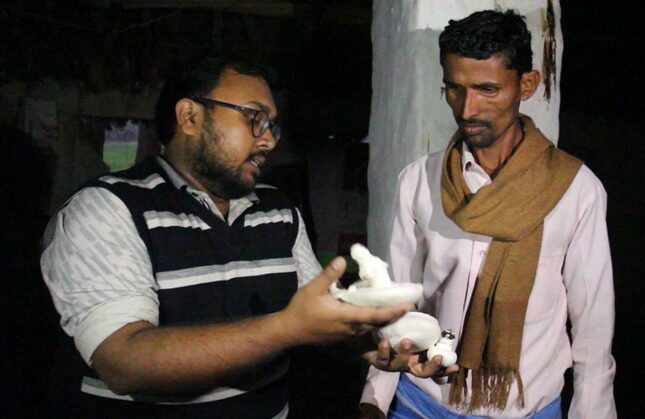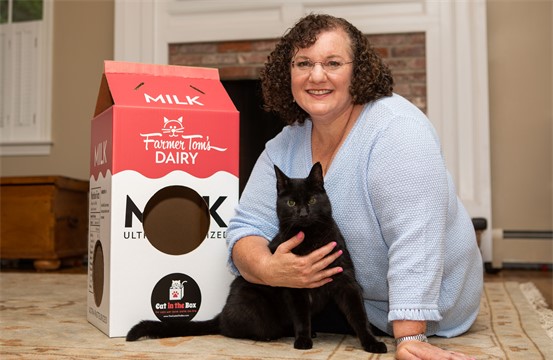This inspiring story is of a rising startup called Cat in the Box started by Dawn LaFontaine in the e-commerce space to create products that meet an unfilled need in cat products. Here is the story of Cat in the Box in Dawn’s own words.
When we bring cats into our world, we often think about how they will fulfill our need for love and companionship. But we don’t always explore deeply enough what their needs are, and how living in our homes may not satisfy them. Cat in the Box designs products that meet both cat and owners’ needs with products that are USA-made, eco-friendly, and most importantly, cat safe.
Introduce us to your idea of Cat in the Box
Cat in the Box makes whimsical cardboard boxes for cats who think inside the box.
Cats are crazy for boxes: tissue boxes, mailing tubes, cereal boxes, the lid to Monopoly. Put a box on the ground and all the neighborhood cats will be inside before you turn around.
Even if you don’t own a cat, you probably already knew that cats are obsessed with cardboard boxes. It’s the stuff of YouTube videos and internet memes galore. It’s such a universal phenomenon that scientists have come up with compelling research about why cats are so cardboard box crazy.
The question then isn’t why cats like cardboard boxes, but why owners put up with filthy, ugly boxes in their homes. Cat in the Box boxes are fun, attractive, environmentally friendly, and imprinted with cat-safe inks. And cats love them.
What’s your strategy story? What led you to start Cat in the Box?
I’m not your typical entrepreneur. I’m a middle-aged, former stay-at-home mom who had not held a traditional job in over 23 years when my second child left for college.
When I started this business nearly three years ago, I had no entrepreneurial experience. I had no financial backing and I was using my husband’s severance payout from a long-time job he’d just lost. Prior to my decision to step back from my career to raise my family, I’d been the big “breadwinner” in our family.
In the intervening years, I’d watched my husband grow in his own career and I realized that I didn’t have enough working years left in my life to achieve what he had in the two decades that I’d been away. I decided that I needed to take control of my own working future.
I’m a lifelong animal lover who got the idea for this business after visiting my mother’s cat sitter. This woman had a beautifully decorated home, but the living room was filled with old shipping cartons. She saw me looking around and said, quite sheepishly, “They’re for the cats.” I already knew that cats are crazy for boxes but it got me thinking, why do cat owners put up with dirty, ugly Amazon boxes in their homes. Why not boxes that are clean, cat-safe, and fun?
What marketing, operation strategies are you adopting at Cat in the Box?
My business is completely self-funded and bootstrapped. My “strategy” is learning to do everything myself, from being my own webmaster, to being my own bookkeeper. I design my own products, I pick them up from my manufacturer in a uHaul, and, with help from my husband, I pack every single one of my products that go out the door to a customer. I’ve been really creative in getting free exposure for my company, including some very valuable media coverage.
Any strategy mistakes you have made and what did you learn?
My first big mistake was in product design. My first two products were really clever and really cute, but had a serious design flaw. They were too big and expensive to ship. When USPS effectively eliminated the shipping category that I was using to get the items out to my customers, I went back to the drawing board. It took almost a year, but I designed a much more compact product that was much more cost effective to ship. An unexpected benefit of the redesign was that it allows me to wholesale my products. I’ve now had some initial success getting my products into retail boutique pet stores.
Finally what advice do business-related or personal) you have for your fellow entrepreneur readers?
My best advice to would-be entrepreneurs is just get started. Many people think that the idea is the thing – that they have to come up with just the perfect product before they can open the virtual doors of their dream business.
Now I know that it’s not about the idea as much as it is about the implementation. Implementation is the thing that’s hard to learn. But once you learn it, the information is yours to keep forever and to apply to other ideas and other endeavors.
If like me, you learn that your “perfect” idea isn’t so perfect, it won’t matter. Because every step you take leads you to the next step that you know you have to take. But first, you have to just start.
Disclaimer: The information in the above story is provided by the startup and The Strategy Story takes no responsibility for the authenticity of the product and services offered by the startup. Reader’s discretion is advised.
Check out stories of other aspiring Entrepreneurs
Also, check out our most loved Startup Strategy Stories below

How one man is enabling Rural India to be financially independent?
Mayank and his startup SumArth are transforming farming from an occupation to a respectful profession in rural areas of Bihar?

How Ajeet Khurana selects startups for investment and mentorship?
Ajeet Khurana has been a name quite synonymous with the Indian Startup space. The Strategy Story interviewed Ajeet Khurana to know his startup strategies

How a few professionals are reducing unemployment due to COVID-19?
Retain The Star has come up with Talent loan concept where a company provides its employees on a contract basis to other companies looking for similar skillset

How did one man leave a career of 25 years to live the “GREAT AMERICAN DREAM”?
Would you leave a comfortable life and a stellar career to start something? Read about Vivek’s journey to live the Great American Dream

Is there a right age to start your entrepreneurship journey?
Is there a minimum age into the entrepreneurship world? Guess not. Atharv Patil started his first venture at the age of 13. Find how?






